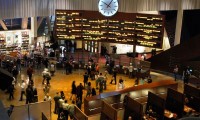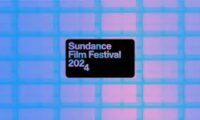BLUE IS THE WARMEST COLOR: Buy A Ticket – A 3-Hour Deep Dive Into A Character’s Soul
BLUE IS THE WARMEST COLOR is relentlessly, sometimes suffocatingly intimate. By that I don’t mean its celebrated, lengthy (although simulated) sex scenes between lead characters Adele (Adele Exarchopolous) and Emma (Lea Seydoux), which have earned it an NC-17 rating in the US, or at least not merely those. Throughout its exhausting 3-hour length, co-writer/director Abdellatif Kechiche can’t get his camera close enough to the characters, especially Adele. He pushes in so crushingly on her face that he seems to want the lens to vanish within her flesh, to chart his drama as it plays out along her very arteries; shots are wildly, dizzyingly hand-held, even when there’s no reason for them to be apart from the filmmaker’s own swooning emotion. Exarchopolous and Seydoux have spoken very publicly and bitterly about their treatment at Kechiche’s hands; he seems to have an advanced case of Neo-Kubrickitis, demanding dozens of takes, including of the sex scenes, and sparing no feelings in his assessments of their work. His film is very much the product of that kind of obsession; it feels like the work of a filmmaker who’s barely slept since he first called “Action!”
There’s nothing in the material itself that demanded this kind of epic treatment. Based by Kechiche and Ghalia Lacroix on the graphic novel by Julie Maroh, it introduces Adele when she’s still a high school student with a boyfriend. When she sees Emma, with her blue-dyed hair, one day in the street walking with her girlfriend, it changes Adele’s life, although in incremental stages. The first section of Blue follows the relatively standard pattern of coming-out stories, as Adele denies her desires, gets to know Emma initially as a friend, and only gradually acknowledges her deeper feelings, leading to the wildly passionate sequence that largely earned the film its MPAA rating (because, as we all know, an almost unlimited amount of brutal violence is suitable for children, but no one under 17 should ever be exposed to scenes of loving sexuality).
Kechiche’s use of time and pace in Blue‘s first half can be exasperating. We all know where the story is going as soon as Adele and Emma catch sight of each other, and taking an ordinary movie’s feature length to get there feels unduly long, with scenes of conversation that go on and on–sometimes Blue feels like mumblecore, and not in a good way–as the camera flies around the speakers like an annoying 12-year old who’s just gotten his first camera-phone. (Sofian El Fani is the cinematographer, obviously doing Kechiche’s bidding.) But there is a plan to it all. Kechiche’s insistence on dwelling on the specificity of Adele and Emma, and on expanding the story into the dimension of time, makes for a far more emotionally complex second half once the two of them are a couple. We know about their interests (Adele wants to teach, Emma is an artist), their social standing (Adele is from a disapproving middle-class family, Emma’s parents are artistic and liberal), their politics, moods and attitudes. Scenes of infidelity, strain, furious fights and reconciliation are rooted in character rather than genre. A climactic sequence in which Adele and Emma meet at a restaurant after some period apart evokes the Bergman of Scenes From a Marriage, as layers of time, sexuality, longing, anger, confusion, pain and closure unfold with spectacular intensity.
The Cannes Film Festival jury, in giving Blue its grand prize, made the unprecedented decision to award not just Kechiche but Exarchopolous and Seydoux as well, and the film seems so tied to the two of them as individuals that with other actresses, it would be a different work. Kechiche didn’t discover either of them (Exarchopolous has been making films since she was 12, and Seydoux has even been in Hollywood’s orbit with roles in Midnight in Paris, Inglourious Basterds and Mission: Impossible 4), but under his direction, however unpleasant it may have been, he’s dug into them and found depths of emotion that again bring Bergman to mind, and his work with actresses like Liv Ullmann and Ingrid Thulin.
People who go to see Blue Is the Warmest Color for the sex will find themselves like an earlier generation who read James Joyce’s “Ulysses” for the same reason, putting in a lot of work for, especially in the Internet age, limited return. Blue is, however, an extraordinary film, both tiresome and gripping, all-too-familiar and stunningly original, infuriating and exhilarating.




